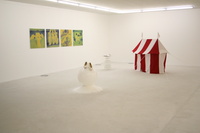Visual Arts

Nonetheless, down the centuries, folk artists, craftsmen and seamstresses found outlets for their creativity in a wide range of artistic work, but it was not until the middle of the 19th century that fine art began to establish itself in Iceland.
Sigurður Guðmundsson “the Painter” (1833-74) was a pioneer in the field (hence his soubriquet): he called for an artistic awakening, in harmony with the awakening of national consciousness and pride that was taking place in his time. Sadly, Iceland was not ready for this forward-looking free spirit, who died, far before his time, of malnutrition.
But with the dawn of a new century, and progress and development in Icelandic society, fine art gained a foothold: the first professional artist was Þórarinn B. Þorláksson (1867-1924), followed by other trail-blazers such as Ásgrímur Jónsson (1876-1958), Jón Stefánsson (1881-1962) and Jóhannes S. Kjarval (1885-1972). Einar Jónsson (1874-1954) was Iceland´s first sculptor, followed by Ásmundur Sveinsson (1893 -1982), Sigurjón Ólafsson (1908 - 82) and Gerður Helgadóttir (1928 - 75), to name but a few.
Icelandic artists, who traveled abroad to train at academies of art, and often spent many years away from Iceland, brought home with them international trends and influences: Jón Engilberts (1908-72), for instance, exhibits attributes of German Expressionism in his early work, Nína Tryggvadóttir (1913-68) was influenced by Cubism, and Svavar Guðnason (1909-88) was a temporary member of the avant-garde CoBrA group of artists, whose playful approach to colour and form is manifested in his work.
Since the late 1960s, conceptual art has been influential in Iceland. One of the leaders in this field of artistic endeavour is Sigurður Guðmundsson (b. 1942), one of Iceland´s most international artists, who works in performance, photography, drawing, printing, sculpture, installations, and even music and fiction. Rejecting all artistic boundaries, he goes his own way.
Dieter Roth (1930-98) was – and still is – a major influence on the younger generations of Icelandic artists. Originally Swiss-German, Roth lived partly in Iceland: his art spanned drawing, jewelry and furniture design, film, painting, sculpture, writing and music.
His work, which invariably broke artistic boundaries, is still reflected in installations by younger artists; he was also a proponent of collaboration between artist in different fields, an idea which has gained a growing following over the years. Such broad collaboration is characteristic of the Icelandic art world today.
From late 2010 many exhibitions will be held in German galleries, including one-man and –woman shows, and a large-scale retrospective of 150 years of Icelandic art.
Venice Biennale
Ragnar Kjartansson was Iceland´s representative at the Venice Biennale in 2009. For more information on Iceland´s participation in the Biennale, and on Icelandic art and artists, visit the Centre for Icelandic Art website.
Links to Museums and Gallerys:
National Gallery of Iceland - Ásgrímur Jónsson collection
Reykjavik Art Museum - Asmundarsafn - Hafnarhus - Kjarvalstadir
Fold Gallery